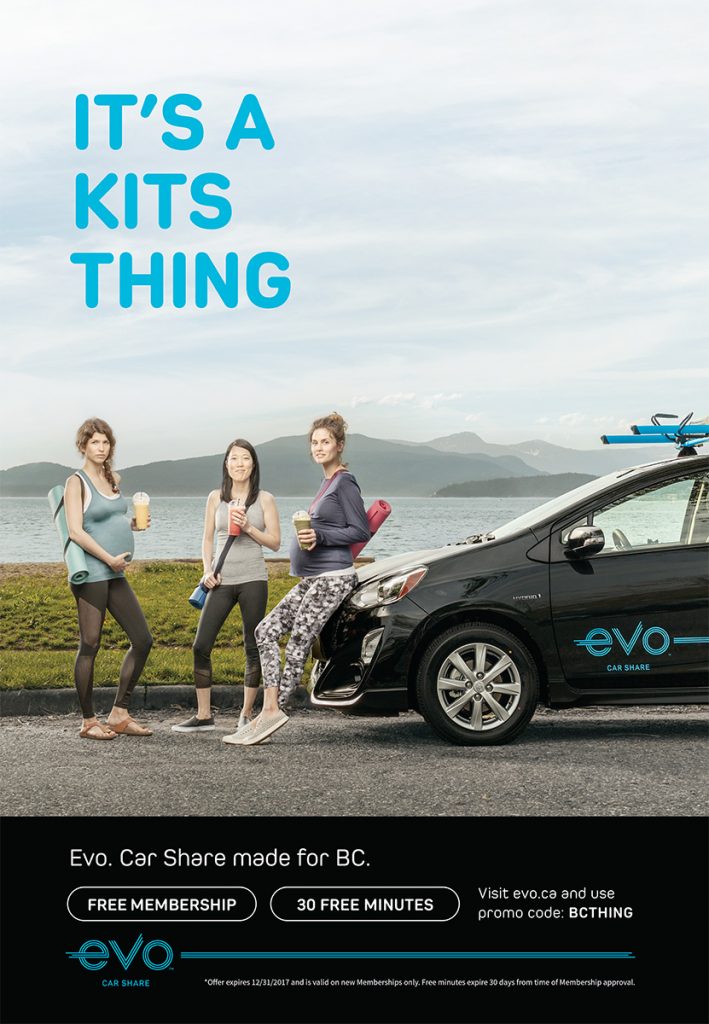
If you regularly ride transit then likely you have seen this advertisement for a car share service named Evo. This particular advertisement is one of several in their overall campaign, and each one features a specific neighborhood, or area of Vancouver. The aim of this campaign is to appear relatable to Vancouverites, by presenting snapshots of Vancouver culture in a way that plays on stereotypes.
This ad presents a snapshot of Kitsilano, which features 3 women, 2 of whom are pregnant, standing with the ocean and mountains behind them. The women are all holding smoothies, wearing yoga clothing, and above them are the words, “it’s a kits thing”, referring to the Kitsilano neighborhood.
At first glance it is a somewhat humorous image which pokes fun at Kitsilano stereotypes. However, if you peel back the layers of history to unravel how we have come to this point where yoga pants and smoothies symbolize a community, a disturbing reality appears.
Firstly, the name Kitsilano is an anglicized version of Squamish chief August Jack Khatsalano’s name. Beginning in the early 1900s, the provincial and federal government used fraudulent, coercive, and illegal means to appropriate the Kitsilano reserve lands which had been set aside for the Squamish people. It was with an incredible sense of entitlement and superiority that white settlers justified their theft of indigenous land. They believed that because First Nations peoples were not using the land in a way that they thought was appropriate that they had no rights to the land. Furthermore, as Vancouver underwent the urbanization process, the Kitsilano reserve was viewed as an impediment to development, as well as an unsightly blemish that needed to be fixed. For thousands of years Squamish and Musqueam peoples lived off of the resources this land had to offer, and within a century their presence has all but been erased and forgotten.
Now, when we look back to this ad, what do we see? We see individuals who can afford to buy expensive yoga clothing and expensive beverages, and who can afford to start families. We see wealth that was built upon the appropriation of indigenous land. This image is not just a cute snapshot of a trendy neighborhood, it also represents the forced removal of indigenous bodies and the subsequent erasure of their history and voices.
Jammed Version

In my “jammed” version of this ad I have attempted to create a snapshot of indigenous history in the land that has become Kitsilano, in a way to fight against indigenous erasure. I replaced “kits” with the word “Sen̓áḵw”, which is the Sḵwx̱wú7mesh (Squamish) name for the Kitsilano reserve. I also replaced the image of the women and the car with a photo of indigenous people who lived in Sen̓áḵw, which was taken in 1891. I changed “BC” to “Coast Salish territories”, and also changed the promo code with the name, “Khatsalano”.
With these edits I am essentially trying to convey that it is not just a “kits” thing, that there is another narrative that exists and needs to be told. Incorporating the Squamish language and pointing out that this is not just BC but also Coast Salish territories as well, is a way to make indigenous presence visible. It was also important to incorporate August Jack Khatsalano’s name, as his name was anglicized and appropriated by white settlers to rename the land they seized as “Kitsilano”. Whereas the original ad is a snapshot of how white settler expansion has displaced and erased indigenous people and their history, this ad aims to make this forgotten and overlooked narrative known.
With this reconstruction I also tried to contrast the colorful and lighthearted tone of the original ad, by conveying a more somber tone with the photo and language. This is done to acknowledge the serious harm that was done to the indigenous peoples and also to evoke a reaction from the audience. This ad is less relatable than the original and presents a dark history of the land we occupy, and so it may make audiences feel a sense of discomfort, or maybe even defensiveness. Ultimately, whatever reaction this ad elicits from an individual, it gives them a chance to question the dominant narrative. It is time to disrupt these harmful stereotypes that are used to represent Kitsilano, and other unceded indigenous territories, and make indigenous history and presence known.
References:
Barman, J. (2007). Erasing indigenous indigeneity in Vancouver. BC Studies, (155), 3.
Wallstam, M., & Crompton, N. (2013, July 25). City of perpetual displacement: 100 years since the destruction of the Kitsilano Reserve. The Mainlander. Retrieved from http://themainlander.com/2013/07/25/city-of-perpetual-displacement-100-years-since-the-destruction-of-the-kitsilano-reserve/